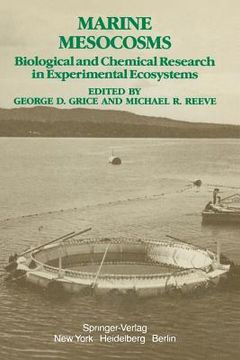Share
Marine Mesocosms: Biological and Chemical Research in Experimental Ecosystems (in English)
Grice, G. D. ; Reeve, M. R. (Author)
·
Springer
· Paperback
Marine Mesocosms: Biological and Chemical Research in Experimental Ecosystems (in English) - Grice, G. D. ; Reeve, M. R.
$ 104.20
$ 109.99
You save: $ 5.79
Choose the list to add your product or create one New List
✓ Product added successfully to the Wishlist.
Go to My WishlistsIt will be shipped from our warehouse between
Thursday, July 11 and
Friday, July 12.
You will receive it anywhere in United States between 1 and 3 business days after shipment.
Synopsis "Marine Mesocosms: Biological and Chemical Research in Experimental Ecosystems (in English)"
Techniques developed for enclosing viable natural planktonic ecosystems pro- vided the opportunity for prolonged and detailed investigation of dynamic events within the pelagic system of a known water body. Recent investigations into plankton ecology, using enclosure systems in dif- ferent marine environments, are discussed in relation to the data obtained from the Nanaimo, British Columbia, Canada, plastic-sphere experiments of 1960 and 1962. Three types of modern enclosure experiments are recognized: floating systems within nutrient levels maintained or running down, and benthic attached systems. The review largely discusses results from the two kinds of floating systems. Processes at several trophic levels have been investigated in enclosures. This review attempts to draw together details from all experimental systems to emphasize the enclosures' contribution to our understanding of planktonic systems. Enclosures made it possible to examine primary production processes, particularly in relation to inorganic nutrient availability and water-column sta- bility. Recent experiments have used the understanding of these processes as a management technique in maintaining different planktonic systems. Relation- ships between primary and secondary trophic levels are not always easy to inter- pret, since the growth of primary carnivore populations can often determine the survival of zooplankton populations. Nevertheless, the development of co- horts of herbivorous zooplankton has been followed in several enclosures, yield- ing useful information on development times and production rates. In enclosed systems it is thus possible to directly relate tertiary level production to inorganic nutrient input, and to calculate production rates and exchange efficiencies at several trophic levels.
- 0% (0)
- 0% (0)
- 0% (0)
- 0% (0)
- 0% (0)
All books in our catalog are Original.
The book is written in English.
The binding of this edition is Paperback.
✓ Producto agregado correctamente al carro, Ir a Pagar.

